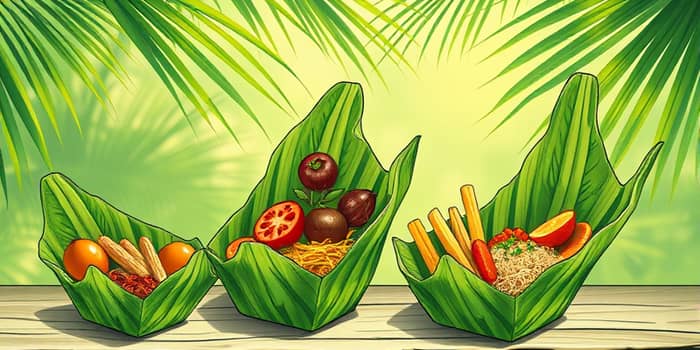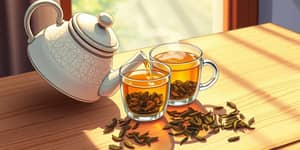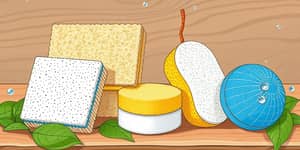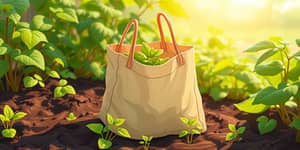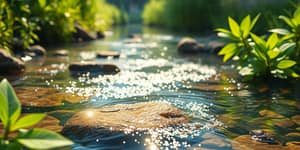In an era defined by endless convenience and rapid consumption, the shadow of single-use plastics looms larger than ever. Every day, billions of plastic bags and containers are discarded, contributing to mounting landfills, polluted waterways, and endangering wildlife across the globe.
Amid this environmental crisis, a simple, traditional material is making a triumphant return. Across markets and streets, banana leaves are stepping in to transform the way we package and enjoy food, offering a sustainable and innovative alternative to takeout containers.
This revival is not just about wrapping food; it is a celebration of cultural heritage and a testament to human creativity in the face of ecological challenges.
The global plastic packaging crisis
Worldwide, over five trillion single-use plastic bags are consumed each year, persisting in nature for up to two millennia. This relentless pollution devastates landscapes, clogs waterways, and threatens the survival of up to two hundred million land and aquatic animals annually.
Moreover, plastic packaging accounts for more than a billion tons of waste sent to landfills every year, exacerbating soil degradation, exacerbating flooding, and eroding tourism revenues in vulnerable regions.
The health implications of plastic pollution extend far beyond waste. Microplastics infiltrate water supplies and enter food chains, posing long-term risks to human well-being and undermining global efforts toward public health.
Reviving an ancient tradition with modern science
Long before plastic dominated the global market, cultures across Asia and beyond used banana leaves to wrap, serve, and protect food. These leaves were prized for their natural waterproofing, gentle aroma, and bright green hues.
Today, innovators have harnessed that heritage and coupled it with cutting-edge technology. An eleven-year-old inventor in India, Tenith Adithyaa, pioneered a patented technology that enhances banana leaves, making them stretchable, crush-resistant, and able to withstand extreme temperatures.
Processed banana leaves now boast antiviral, antifungal, and antibacterial properties, ensuring safe food contact without resorting to chemicals. They maintain their vibrant green color for up to a year or remain functional for three years when color is not essential.
In local markets from Thailand to Brazil, craftsmen and street vendors have long revered the banana leaf for its simplicity—a natural gift from the tropics, flexible enough to cradle curries yet sturdy enough for grilled delicacies.
Properties making banana leaves ideal for takeout
Banana leaves offer a suite of advantages that align perfectly with modern takeout demands:
- Biodegradability: Break down in about twenty-eight days under natural conditions.
- Abundance: Sourced as a by-product of banana farming, with no extra land required.
- Waterproof and clean: Naturally slick, easy to rinse, and perfect for direct food contact.
- Durability: Enhanced strength and elasticity support heavy loads and hot or cold foods.
These qualities make banana leaves a compelling choice for plates, boxes, cups, and even writing paper and envelopes, all without contributing to microplastic pollution.
Beyond function, the visual charm of glossy green leaves enhances the dining experience, reconnecting eaters with nature and infusing each meal with a sense of authenticity.
Ecological and economic advantages
Switching to banana leaf packaging offers tangible benefits for businesses, consumers, and the planet alike.
- Reduces plastic pollution and landfill waste dramatically.
- Saves up to four billion trees annually when replacing wood-derived packaging.
- Aligns with multiple UN Sustainable Development Goals, from responsible consumption to climate action.
Moreover, post-use, these leaves seamlessly re-enter the natural cycle: compost them to enrich soil or feed them to livestock, embodying a truly circular economy packaging solution that respects nature’s rhythm.
Cost analyses indicate that production expenses for banana leaf packaging can be comparable to recycled plastic alternatives, especially when factoring in savings from waste management and environmental remediation.
Industry adoption and success stories
Banana Leaf Technology and similar ventures have developed over thirty distinct products, from biodegradable plates to stylish cones and durable boxes. By licensing their processing methods, they empower businesses globally to create localized sustainable packaging.
Consumer research reveals high acceptance rates, with many praising the unique aesthetic appeal and eco-friendly promise of banana leaf packaging. In regions across Asia, Indonesia, and beyond, cafés, food stalls, and restaurants are embracing this shift, signaling a growing movement against plastic waste.
In Indonesia, an eco-conscious eatery reported a 30% reduction in plastic waste within months of switching to banana leaf plates, attracting positive media coverage and new customers eager for sustainable dining.
Challenges and the road ahead
Despite its promise, banana leaf packaging faces hurdles on the path to mainstream adoption. Untreated leaves naturally degrade quickly, requiring processing facilities that add layers of complexity and cost.
Additionally, while moisture resistance is suitable for most foods, some applications demand further enhancements to match the impermeability of plastics. Scaling production to meet global demand will also require infrastructural investments and streamlined supply chains.
Climate fluctuations can impact banana harvests, creating potential supply bottlenecks. To mitigate this, partnerships with growers and investment in resilient agricultural practices are essential.
Looking to the future
As technology continues to advance, banana leaves may expand into even more sectors. Innovations could yield fully waterproof sheets for industrial use, biodegradable films for frozen foods, or sustainable wrapping for non-food products.
Imagine global fast-food chains collaborating with banana leaf innovators to pilot flagship stores, showcasing zero-waste packaging for every order and inspiring industry-wide transformation.
By integrating banana leaf packaging into large-scale supply networks and collaborating with policymakers, the world can reduce plastic dependency and forge a healthier relationship with our environment. With each wrapped meal, we take a small but significant step towards healing the planet.
The shift from plastic to banana leaves is more than a packaging choice; it is a statement of our values. Embracing this eco-friendly alternative demonstrates that innovation and tradition can unite to protect Earth’s future.
As consumers, entrepreneurs, and policymakers, we each hold the power to redefine convenience and sustainability. By choosing banana leaf packaging, we honor an age-old practice and pioneer a new chapter in environmental stewardship.
Together, let us wrap our meals—and our planet—in the vibrant green of hope and resilience.
By embracing banana leaf solutions today, we sow the seeds of a cleaner, greener tomorrow for generations to come.
References
- https://www.biobasedpress.eu/2019/09/processed-banana-leaves-an-eco-friendly-packaging-solution/
- https://www.vikea.id/green-and-sustainable-banana-leaves-food-packaging/
- https://www.unileverfoodsolutions.us/chef-inspiration/food-delivery/eco-friendly-takeout-containers.html
- https://bioplasticsnews.com/2019/09/21/banana-leaves-packaging/
- https://reafindoagriculture.com/sustainability-in-agriculture-how-indonesian-banana-leaf-support-eco-friendly-packaging
- https://www.gbg.co.zw/2021/08/05/packaging-with-banana-leaves-gains-popularity-across-the-world/

